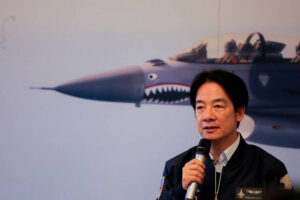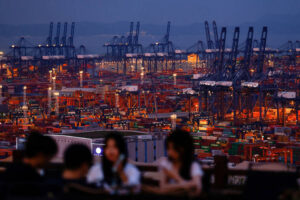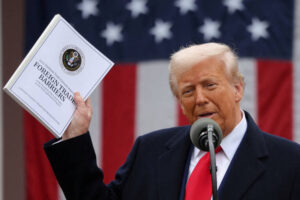PYONGYANG, North Korea — North Korean leader Kim Jong Un hailed his country’s recent nuclear test to uproarious applause as he convened the first full congress of its ruling party since 1980, an event intended to showcase the North’s stability and unity in the face of tough international sanctions and deepening isolation.
PYONGYANG, North Korea — North Korean leader Kim Jong Un hailed his country’s recent nuclear test to uproarious applause as he convened the first full congress of its ruling party since 1980, an event intended to showcase the North’s stability and unity in the face of tough international sanctions and deepening isolation.
Kim, who stood to read his opening remarks Friday before more than 3,400 delegates, was interrupted repeatedly by cheers and applause as he laid out accomplishments since he took power in 2011 — including what the government says was its first hydrogen bomb test in January.
Along with being high political theater, filled with pomp and ceremony, the convention is a major milestone for the young North Korean leader, who was not yet born when the previous congress was held 36 years ago.
Kim wore a black dress suit, grey tie and horn-rimmed glasses that resembled the ones worn by his late grandfather and North Korean founder, Kim Il Sung.
He praised the January nuclear test and a February satellite launch, seen by outside governments as a banned test of dual-use missile technology, saying they demonstrated the nation’s “dignity and power at the highest level.”
He also praised the outcome of a recently completed 70-day “loyalty campaign,” in which workers nationwide were called upon to put in extra hours to boost productivity.
To make sure the event gets global attention, North Korea has brought in a large number of journalists from around the world. But they were shown only the outside of the venue as the congress began before being bused off to — of all places — a wire factory.
To put its best face before the cameras, the city has been spruced up with freshly painted walls and lots of posters and flags. As a light rain fell Friday, large groups of students and workers could be seen around the capital preparing for parades and rallies that will be held in conjunction with the congress.
North Korea has held other big meetings of its ruling Workers’ Party since the 1980 congress — notably in 2010 and 2012 — but all six previous congresses came under “eternal president” Kim Il Sung, who died in 1994.
This one could provide a major opportunity for Kim Jong Un, who has yet to travel abroad or meet any world leaders, to step out of the shadows of his grandfather and father.
“Now we are greeting the new era of Marshal Kim Jong Un,” said Pyongyang resident Choe Un Su, a 75-year-old retiree who was out Friday for a walk.
Kim Jong Un has patterned himself more closely after his charismatic grandfather than his notoriously reticent father, Kim Jong Il, who almost never spoke in public. Kim Il Sung spoke on the first day of the 1980 congress — though Friday’s brief opening speech came nowhere near the five-hour address given by Kim Il Sung.
The government has built up the congress for months, but has not announced a detailed itinerary, or even when the meeting will end. Kim Jong Un’s speech wasn’t made public until late Friday night, when it was broadcast on the television news.
The state-run Korean Central News Agency on Saturday said that the agenda for the congress included reviewing the works of the party’s Central Committee and Central Audit Commission, revising party rules, electing Kim Jong Un to an unspecified top party post, and electing a new central leadership for the party.
The congress is the party’s highest-level decision-making body, though the real decisions are made by Kim and his inner circle.
So far, the focus has been on praise for Kim and his successes on the nuclear front, along with improvements since he assumed power to boost the nation’s standard of living — themes the media hit hard as the congress approached and trumpeted again loudly on Friday.
The congress will also be colored by the anti-U.S. bravado that marks so much of North Korea’s worldview — that it is an underdog forced to pursue nuclear weapons in defense against the Goliath that is Washington.
As Kim’s mention of the H-bomb test suggests, North Korea’s government has made clear it has no intention of backing down in its nuclear development program — and instead wants to be recognized as a nuclear power.
Hours before the start of the congress, the KCNA boasted of the country’s military achievements, including claimed advancements in developing nuclear warheads, missile re-entry vehicles and long-range rocket engines.
It said the congress would be a historic celebration of how Kim Jong Un’s guidance has elevated the country into a “nuclear, space power” and pushed it into the “absolute prime” of its efforts to build a “thriving nation.”
The gathering will likely also provide some insights into what Kim’s other priorities are and who he wants to help him carry them out.
The economy is certainly high on Kim’s list, but his “byongjin” guns-and-butter policy of developing North Korea’s nuclear weapons while also building its domestic economy is seen by many outside economists as unlikely to succeed because of the heavy price the nuclear program brings in international sanctions that keep the country’s economy from growing.
Kim is expected to replace the party’s old guard with younger elites loyal to him and may formally elevate his younger sister, Kim Yo Jong, to a position that would essentially make her his second-in-command.
Believed to be in her late twenties, she is currently a vice department director at the party’s Central Committee and frequently appears at her brother’s public events, standing out amid elderly male officials.



